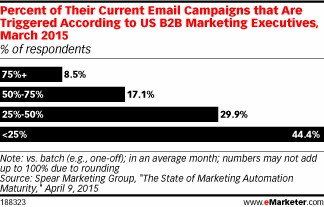Formerly WebStrategies Inc
Blog
Signals from the Field
Subscribe to learn more about inbound marketing & sales development inspiration. New content added weekly.

Driving More Traffic to Your Security Company Website

When it comes to marketing any home services product, it’s important to keep the end goal in mind. Whether you’re talking about a plumbing company, HVAC, Security Company or any other home services business, recurring revenue from annual inspections, regular service and upgrades allow steady growth over time, but almost all live or die by the flow of new customers.

Preston Kendig
Jun 3, 2015

Get better marketing results by reverse engineering your customers
Over the last 11 years in the marketing space, we've identified two over-arching reasons why some marketing plans don't work. The first is a failure to adequately measure the lead and lag metrics of a campaign. The lead metrics are those actions that might ultimately lead to a qualified prospect or a sale. The lag metrics are the bottom line - leads generated, sales made, email signups, etc. You get the idea. The second reason is a failure to understand what is important to the customer. Think about it - how can you effectively communicate and motivate a buyer to consider you if you don't know what's important to him/her.

Neal Lappe
May 31, 2015

How does central VA use the internet?
Hey Central VA - we love our city and we're a creative, talented and unique group of people - don't you think? And, we're into technology - we embrace the internet and the digital world. Now, you can be part of a study that will help us all get more from the internet.

Neal Lappe
May 30, 2015

How To Understand The Customer Journey

The customer experience is more fragmented than ever.

Chris Leone
May 29, 2015

Create a sales & marketing machine - 4 steps to sales success
How to win the hide & seek game with your buyers

Neal Lappe
May 21, 2015

Local Business Orders & Appointments Now Available Through Google My Business
Local business orders & appointments such as food delivery, dinner reservations, and booking service appointments can now all be made via a business’ Google My Business page.

WebStrategies
May 21, 2015

Facebook Like Box Plugin Expiring June 23rd, 2015
Facebook has recently announced that there are important changes coming for their social plugins, most notably the Like Box and Activity Feed. If you currently have a Like Box plugin on your site, as of June 23rd, 2015, you will need to update to the new Page Plugin instead. If you do not, the plugin will no longer work. There is no update for the Activity Feed, it simply needs to be removed for your site before June 23rd.

WebStrategies
May 12, 2015

3 compelling reasons to be a blogger
Blogging is "the bomb" and this post gives 3 compelling reasons to blog, along with some suggestions about how to get started. However, first, let's get one thing straight. For those of you on the younger side of the curve, use of the phrase "the bomb" was popularized in the 90's and according to the Urban Dictionary means "exceptionally cool". Now that we've established that, let's talk about why blogging is "the bomb".

Neal Lappe
May 8, 2015

What Keywords Should I Target?
Getting your website found in the search engines begins with identifying the proper keywords. While this is a critical first step, many websites do it wrong. So let’s fix that.
The following is a common-sense approach to identifying the most important keywords your website should target.
If you’re too busy to do this yourself, pass it off to a restless intern. They won’t need any coding or SEO background. Just think of it as “keyword research for dummies.”
Throughout this post, we’ll look at the fictitious company “Hickory Industrial Pumps.”
Step 1: Optimize for the content already on your website.
For websites that lack any search engine optimization, we recommend beginning from the inside out. This means creating a keyword list based on the content that already exists on your website.
To do this, go through each page on your website and determine the one non-branded phrase (just one) that best represents each page.
A non-branded phrase doesn’t include your brand name. So in the case of Hickory Industrial Pumps, this would mean any phrase that excludes the word “Hickory.”
These core phrases should be 2-3 words in length, e.g. “industrial pumps,” “commercial chemical pumps.”
This becomes your initial keyword list.
Step 2: Determine which core areas of your business are not represented by your existing content.
After completing step 1, you may find your list is short and incomplete relative to your business offering and marketing objectives.
For example, Hickory Industrial Pumps discovered the terms “commercial pump maintenance,” and “commercial pump accessories,” are absent from their list. Their “Other Offerings” page mentions service and accessories, but there is no single page dedicated to these terms.
This is common. There are many phrases for which a website should attempt to rank, but the website lacks a dedicated page on the topic.
The solution is to create a second list of additional terms relevant to the business, but do not appear on the first list.
This becomes your content production list. So for each search phrase on the second list, you need to create a new page on your site.
If it doesn’t make sense to have a page dedicated to a particular phrase, you should re-evaluate whether it’s even appropriate to rank for it.
The Adwords Keyword Planner can help you prioritize singular and plural variations based on expected search volume, along with deciding between synonymous terms (e.g. using the word “commercial pump” versus “industrial pump”).
Step 3: Identify long tail search terms.
After identifying the core search phrases relevant to you, it’s time to create your “long tail keyword” list.
Long tail terms are the very niche terms (four or more words in length) that have low search volume, but in aggregate, comprise more search volume than single broad terms (2-3 words in length).
Anticipating the unique situations your target market may experience, then developing content around those topics, is an effective way to capture long tail search engine traffic.
This begins with identifying your target market personas. The better you understand their pain points, the better you can anticipate what they might search.
For example, Busy Bob is a decision maker persona who runs his equipment as long as possible. When something breaks, he needs a replacement immediately. He searches, “commercial pumps expedited shipping” in Google. Hickory’s “Need a pump in a hurry page?” page, which lists the process for expedited purchasing and shipping, would align perfectly with Bob’s search query.
Here are a few more things to keep in mind when developing your targeted keyword list.
Should I try to rank for my competitors’ names?
No. Trying to rank for competitor’s name is a common request from our clients. Not only is this very difficult (if not impossible) to accomplish, it’s not a worthwhile strategy.
If a person is seeking out a particular brand, convincing them to abandon their intended path and come to you is very unlikely to happen. Search engines are also unlikely to rank you for terms that don’t exist on your site (refer to step 1 and 2 above). Those two reasons make this strategy ineffective.
The broader the term, the more difficult to rank.
Ranking for broad search phrases (one or two words) is tempting because of the potential for website traffic. But because broad terms can mean different things to different people, most of the search volume isn’t relevant to you.
For example, Hickory may want to rank for the broad term, “pump”. While this gets a tremendous amount of search volume, it doesn’t guarantee the searcher is looking for an industrial pump. Adding the word “industrial” or “commercial” may mean lower search volume, but it guarantees relevance.
Why this approach?
Content drives rankings. Therefore, the search terms we target need to be well represented on the site. That’s why we recommend this content-centric approach.
What next?
Once you have identified the most relevant terms for your website, they need to be properly integrated into the code and page content. An experienced SEO firm (::wink wink::) can further massage your keyword list, prioritize based on search volume, and implement geographic references for optimal impact.

Chris Leone
Apr 30, 2015

6 things small business websites can do to improve leads and sales
A report came out recently about how small & medium sized business (SMBs) owners intend to invest their digital marketing dollars in 2015. When asked which marketing channel they intend to increase investments, 49% said their websites, 6 percentage points ahead of any other digital marketing channel.

Neal Lappe
Apr 23, 2015

Ready for marketing that actually delivers?
Let's build something measurable together.

 Talk to the Team
Talk to the Team